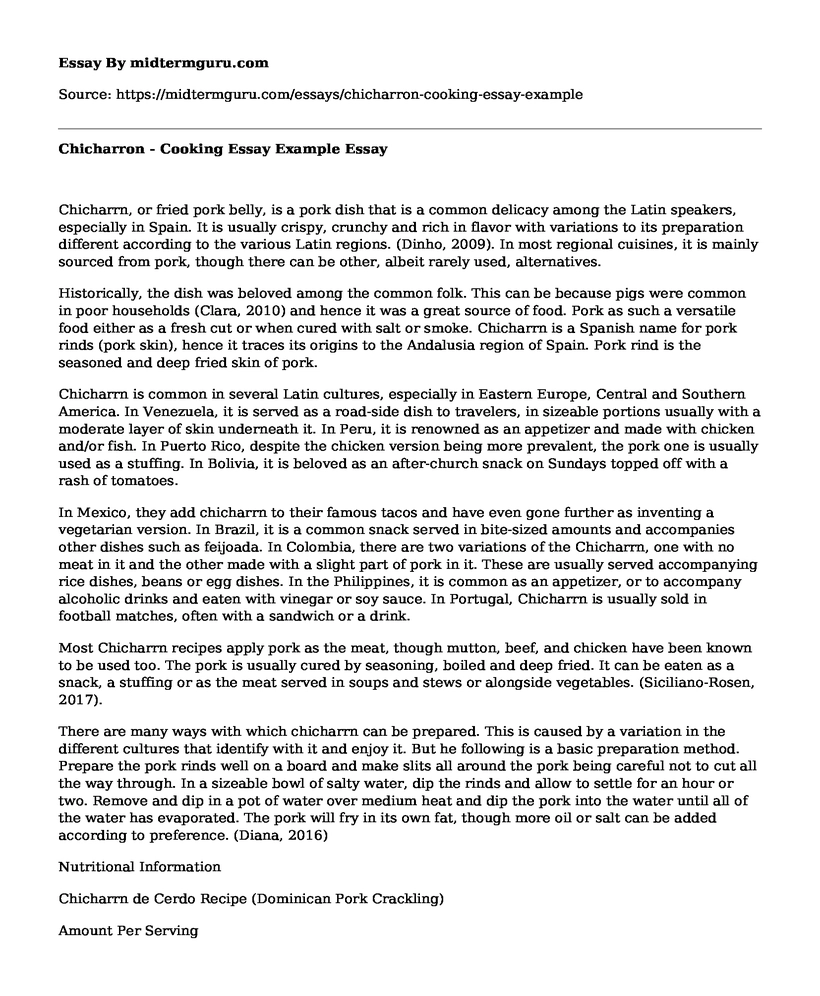Chicharrn, or fried pork belly, is a pork dish that is a common delicacy among the Latin speakers, especially in Spain. It is usually crispy, crunchy and rich in flavor with variations to its preparation different according to the various Latin regions. (Dinho, 2009). In most regional cuisines, it is mainly sourced from pork, though there can be other, albeit rarely used, alternatives.
Historically, the dish was beloved among the common folk. This can be because pigs were common in poor households (Clara, 2010) and hence it was a great source of food. Pork as such a versatile food either as a fresh cut or when cured with salt or smoke. Chicharrn is a Spanish name for pork rinds (pork skin), hence it traces its origins to the Andalusia region of Spain. Pork rind is the seasoned and deep fried skin of pork.
Chicharrn is common in several Latin cultures, especially in Eastern Europe, Central and Southern America. In Venezuela, it is served as a road-side dish to travelers, in sizeable portions usually with a moderate layer of skin underneath it. In Peru, it is renowned as an appetizer and made with chicken and/or fish. In Puerto Rico, despite the chicken version being more prevalent, the pork one is usually used as a stuffing. In Bolivia, it is beloved as an after-church snack on Sundays topped off with a rash of tomatoes.
In Mexico, they add chicharrn to their famous tacos and have even gone further as inventing a vegetarian version. In Brazil, it is a common snack served in bite-sized amounts and accompanies other dishes such as feijoada. In Colombia, there are two variations of the Chicharrn, one with no meat in it and the other made with a slight part of pork in it. These are usually served accompanying rice dishes, beans or egg dishes. In the Philippines, it is common as an appetizer, or to accompany alcoholic drinks and eaten with vinegar or soy sauce. In Portugal, Chicharrn is usually sold in football matches, often with a sandwich or a drink.
Most Chicharrn recipes apply pork as the meat, though mutton, beef, and chicken have been known to be used too. The pork is usually cured by seasoning, boiled and deep fried. It can be eaten as a snack, a stuffing or as the meat served in soups and stews or alongside vegetables. (Siciliano-Rosen, 2017).
There are many ways with which chicharrn can be prepared. This is caused by a variation in the different cultures that identify with it and enjoy it. But he following is a basic preparation method. Prepare the pork rinds well on a board and make slits all around the pork being careful not to cut all the way through. In a sizeable bowl of salty water, dip the rinds and allow to settle for an hour or two. Remove and dip in a pot of water over medium heat and dip the pork into the water until all of the water has evaporated. The pork will fry in its own fat, though more oil or salt can be added according to preference. (Diana, 2016)
Nutritional Information
Chicharrn de Cerdo Recipe (Dominican Pork Crackling)
Amount Per Serving
Calories 1181 Calories from Fat 1080
% Daily Value*
Total fat 120g
Saturated fat 43g 185%
215%
Cholesterol 163mg 54%
Sodium 654mg 27%
Potassium 450mg 13%
Total Carbohydrates 1g
Sugars 1g 0%
Protein 21g 42g
Vitamin A 1.1%
Vitamin 10.2%
Calcium 1.1%
Iron 6.6%
*Percent Daily Values are mainly based on a 2000 calorie diet
Chicharrn is extremely high in sodium and fat and should, therefore, be consumed moderately. A majority of the fat found in chicharrn is unsaturated. They are however an incomplete source of proteins because they lack some essential amino acids.
Chicharrn de Cerdo Recipe (Dominican pork Crackling)
Preparation time: should take 10 minutes. Cook time: 1 hour.
Servings: 4
Ingredients
1.8kg pork belly
1 teaspoon of salt
1 teaspoon of oregano
1 teaspoon, cracked pepper
1 gallon of water
cup lime juice
1 cup frying oil
6 lime wedges for garnish
Instructions
In a thick-bottomed pot, mix the pork belly, water, salt, pepper, oregano and lime juice.
Cook, uncovered, over moderate heat until all the liquid is evaporated. There will be some fat from the pork.
Switch to a Dutch oven, add oil and fry covered until dark, golden brown and crispy skin.
Remove and cool to room temperature.
Cut into small cubes, serve with tostones and garnish with the wedges.
Reference.
Gonzalez C., (2015). Chicharrn de Cerdo
Retrieved from: https://www.dominicancooking.com/1495-chicharron-cerdo-dominican-pork-crackling.html
Wikipedia, (2017): Chicharrn
Retrieved from: https://www.wikipedia.org/wiki/chicharron
Rosen, C., (2017): Chicharrn
Retrieved from: https://britannica.com/topic/chicharron
WikiPilipinas, (2017): ChicharrnRetrieved from: https://wikipilipinas.org/index.php/chicharron
Nizoletti C., (2015): How to Make Chicharrn at Home
Retrieved from: https://www.food52.com/blog/12118-how-to-make-chicharron-at-home
Dinho, E., (2009): Colombian-Style Fried Pork Belly
Retrieved from: https://www.mycolombianrecipes.comcolombian-style-fried-pork-belly-chicharron-colombiano
Cite this page
Chicharron - Cooking Essay Example. (2021, Jul 01). Retrieved from https://midtermguru.com/essays/chicharron-cooking-essay-example
If you are the original author of this essay and no longer wish to have it published on the midtermguru.com website, please click below to request its removal:
- Essay Example: Why Go Vegan?
- Differences in Nutritional Needs Throughout Lifecycle - Essay Example
- Nutritionist Job Research Paper
- Fast Foods Are Not Worth the Risk - Essay Sample
- Gain Healthy Diet Knowledge With $100,000 Fund for Nourishment - Essay Sample
- Health Promotion Plan of Exercising and Better Diet for Patient - Essay Sample
- Celiac Disease: Foods to Avoid, Gluten-Free Diet & Health Benefits - Essay Sample







